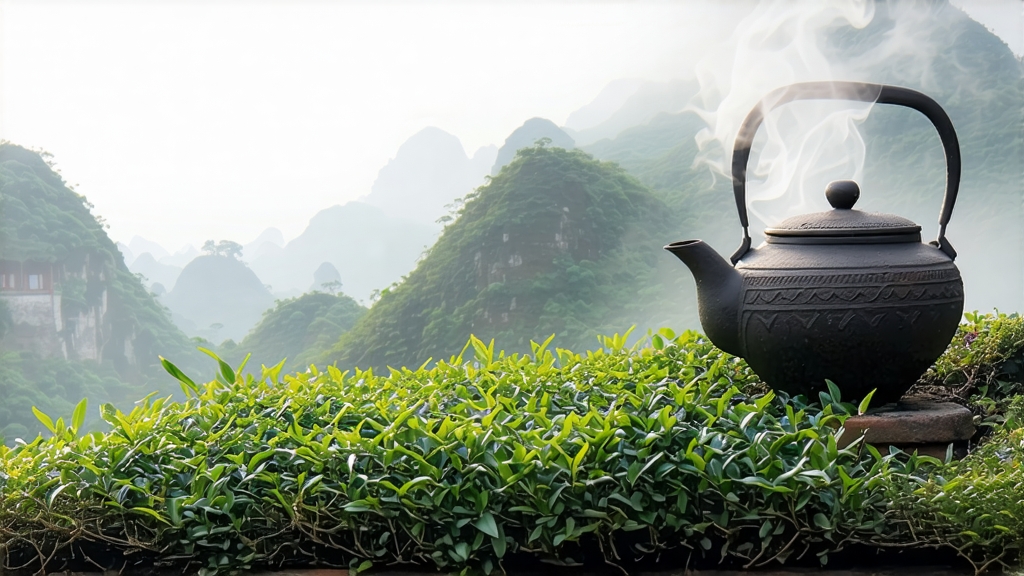
Tucked away in the humid, karst-dotted mountains of southern China’s Guangxi Zhuang Autonomous Region, Liu Bao cha has spent four centuries quietly fermenting its way into the hearts of tea traders, dock workers, and, more recently, global connoisseurs. Often overshadowed by its younger Yunnan cousin Pu-er, Liu Bao is the original “boat tea,” once compressed into coarse bamboo baskets and rafted down the Liu Bao River to the Pearl Delta, where it was loaded onto junks bound for Southeast Asia. There, laborers in tin mines and rubber plantations discovered that the dark, mellow liquor settled stomachs soured by tropic heat and rough rice wine. Today the same tea is courted by collectors who prize its camphor-betel nuance and its uncanny ability to taste older than its years.
Liu Bao’s story begins during the late Ming dynasty, when the Qing-Xiu district of Wuzhou prefecture was ordered to supply “border tea” to troops stationed in the malarial south. Local big-leaf cultivars—varietals of Camellia sinensis var. assamica adapted to Guangxi’s red, mineral-rich soil—were found to withstand the long, steamy journey better if allowed to oxidize and ferment beyond the green-tea stage. By the early Qing, Liu Bao had become a standardized tribute, pressed into 40-kilogram baskets wrapped with banana leaf and rattan. British customs logs from 1886 list “Lew Pow” among the commodities off-loaded in Singapore, priced just below Keemun but above most oolongs, proof that the tea had already stepped onto the world stage.
Although all Liu Bao belongs to the dark-tea (heicha) family, two broad streams exist: Traditional and Modern. Traditional Liu Bao is processed exactly as it was in the Qing—basket-fermented, then left to age naturally in non-climate-controlled warehouses where summer heat and monsoon humidity coax slow microbial activity. Modern Liu Bao borrows the “wet-piling” (wo dui) technique developed in 1970s Yunnan, piling leaves 70 cm deep, sprinkling them with water, and turning them every week for 30–50 days to accelerate fermentation. The result is a tea that drinks like a five-year-old traditional cake within months of production. Purists debate which style offers the truer expression; in practice, both can astonish when handled by a master.
The craft begins in late April, when the first spring flush is plucked “one bud, three leaves,” slightly larger than the standard for green tea. After a brief withering under mountain mist, the leaves are wok-fried at 280 °C for eight minutes, just enough to denature enzymes without sealing the leaf surface. While still hot, they are rolled for 25 minutes on bamboo trays to rupture cell walls, then sun-dried on raised sieves. At this point the maocha looks like rustic Yunnan Dian Hong—twisted, chocolate-brown, with a faint sweet potato aroma.
What happens next decides the tea’s destiny. For traditional Liu Bao, the dried leaf is steamed soft, packed into 50-kilogram gunny sacks lined with banana leaf, and stacked in riverside caves or loam-floored barns. Over months the core temperature climbs to 45 °C, activating a consortium of molds, yeasts, and bacteria dominated by Aspergillus niger and Blastobotrys adeninivorans. The pile is never turned; instead, workers pierce the sacks with bamboo poles to vent hot air, creating the signature “betel-nut” note reminiscent of areca husk and camphor. After 12–18 months the tea is re-baked over local pine wood, giving a whisper of smoke that integrates rather than dominates.
Modern wet-piling condenses this timeline. The maocha is moistened to 28 % humidity, piled under hemp canvas, and monitored for temperature spikes. Skilled pile-masters “break” the heap every seven days, using rakes carved from camphor wood that impart subtle aromatic compounds. Forty days later the leaf emerges near-black, its liquor already the color of garnet. A final low-temperature bake at 60 °C for three hours sets the flavor and reduces moisture to 9 %, low enough for safe long-term storage.
Aging potential is Liu Bao’s trump card. Like vintage Burgundy, the tea softens while gaining aromatic strata. A 2010 traditional basket stored in